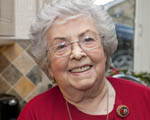 Go to main content
Go to main content
Archive Website of the UK government
Please note that this website has a UK government accesskeys system.
Main menu
Page menu
Home and community

How to reduce trips and falls

Trips and falls account for a large number of injuries in the home, with older people and children more at risk. Find out about the common causes of trips and falls, and how to look out for and avoid hazards.
Common causes of trips and falls
Accidents in the home are often caused by:
- poorly organised and cluttered walkways
- inadequate or unsuitable lighting
- moving or handling a load incorrectly
- rushing around
- tiredness
- physical ability, lack of mobility or lack of balance
- poor eyesight, inappropriate glasses
- medication that can lead to dizziness – older people on four or more different types of medication have an increased risk of falling
Look out for trip hazards
Trip and slip hazards can be a problem in all homes, especially in houses with exposed wooden floors.
Slippery floors
You should look out for:
- spills and splashes of liquids and solids
- wet floors
- changing from a wet to a dry surface
- dusty floors
Cluttered floors
Removing clutter or obstructions on floors, like loose mats or trailing cables, can help reduce the risk of a fall.
Uneven floors
Be aware of:
- changes in surface level or sloping surfaces
- holes and cracks
- unsuitable floor surfaces or coverings – for example loose or worn flooring
Bad weather, which can make surfaces slippery, and unsuitable footwear can also increase the risk of a fall.
Five steps to avoiding hazards
There are five recommended risk assessment steps for keeping slips and trips to a minimum:
- look around for anything that may cause an accident – see ‘Look out for trip hazards’ on this page
- decide who is most at risk
- take preventative measures
- keep a record of what you have changed
- continually check your living space – keep a note of all potential hazards
Keep active to reduce the risk of trips and falls
You can help your general well-being and help to reduce the risk of trips and falls by keeping active and healthy.
A good way to make your muscles stronger and to improve your balance is to take regular exercise. Exercise is important for older people, who are more vulnerable to trip hazards in the home.
You don't have to go to the gym to remain active. Simple tasks like gardening, regular house work and walking can boost energy levels and improve coordination and balance.
Older people - getting help and advice
If you are concerned about any aspect of safety in your home, you can seek expert advice from your local council, who may operate a home safety scheme.
Further specialist help can be obtained from organisations like Age UK, who provide detailed fact sheets and information packs.
Children
Children are prone to trips and falls. You should always do a risk assessment of potential play areas, both at home and when you are out.
The Royal Society for the Prevention of Accidents provides detailed information about how you can help reduce childhood accidents in your home.
 Facebook
Facebook Twitter
Twitter StumbleUpon
StumbleUpon Delicious
Delicious Reddit
Reddit
